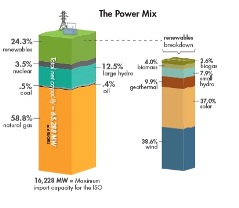PG&E, along with the other utilities, is trying to undermine the regulations that have been so important in developing and growing the State’s solar industry. Learn what’s happening and how to defend what we have.
The growth in renewable solar power in California over the last five years has been, borrowing a word from Donald Trump, “huge.” A key contributor to this growth has been the regulatory concept called “Net Metering.” The figure shows the existing electrical sources in our State. Currently the Solar Power industry employs over 50,000 people. The solar producers are providing over 3,000 megawatts of power to the grid. Maintaining a robust solar power industry is beneficial to our economy and the environment.
 So what is this “Net Metering?” Net Metering means that the customer pays PG&E for the NET electricity used over a period of time or over multiple cooperating entities. For my modest home system, I generate more electricity than I use during sunny July and August. So, in net, PG&E receives more electricity from me than I use. For those months my bill shows a small credit of $10-$20. During the winter my system can offset only a fraction of my electricity usage, so I purchase electricity from PG&E. At the end of a full year of service, PG&E bills me for the entire year of net electricity consumption. A good analogy is a cellphone program that allows the user to roll unused minutes from one month into the next month.
So what is this “Net Metering?” Net Metering means that the customer pays PG&E for the NET electricity used over a period of time or over multiple cooperating entities. For my modest home system, I generate more electricity than I use during sunny July and August. So, in net, PG&E receives more electricity from me than I use. For those months my bill shows a small credit of $10-$20. During the winter my system can offset only a fraction of my electricity usage, so I purchase electricity from PG&E. At the end of a full year of service, PG&E bills me for the entire year of net electricity consumption. A good analogy is a cellphone program that allows the user to roll unused minutes from one month into the next month.
Net Metering in California has fostered many innovations in solar power development and financing. Because the major utilities perceive these innovations as a threat, they are recommending that the California Public Utilities Commission (CPUC) remove or dilute the effectiveness of Net Metering.
PG&E and the other investor owned utilities are also politicking the CPUC to change a variety of rates and fixed charges. PG&E wants to reduce the reimbursement charges for electricity sent to them and increase interconnect fees for solar customers. PG&E and the others are being short-sighted in sabotaging our move to become a fully renewable-energy-state there will be plenty of work to upgrade the electrical transmission network by a factor of three or more.
The CPUC should expand the use of the Net Metering and encourage entities such as farmers, schools, and counties with open space to develop solar projects. The power from these projects could offset the demand of other users or residents. This is called “Virtual Net Metering.” Major companies such as Sungevity (which is a partner with the Sierra Club), Solar City, and Sunrun are producing much of the solar energy in our state using the Net Metering concept. I encourage all readers to contact their city councils and ask them to write to the CPUC. Simply ask the CPUC to maintain or encourage more forms of Net Metering.
Gary is a retired physicist and now an environmental activist. He fosters public understanding of climate change to encourage governments to act.